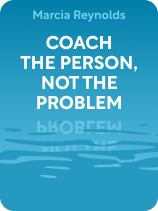

This article is an excerpt from the Shortform book guide to "Coach the Person, Not the Problem" by Marcia Reynolds. Shortform has the world's best summaries and analyses of books you should be reading.
Like this article? Sign up for a free trial here.
Want an overview of Coach the Person, Not the Problem by Marcia Reynolds? What key skills does she say you need to be an effective coach?
Marcia Reynolds wrote Coach the Person, Not the Problem to expand people’s understanding of coaching. She claims that life coaches should help clients challenge deep-seated beliefs, rather than simply giving out advice.
Read on for a brief overview of Coach the Person, Not the Problem by Marcia Reynolds.
Coach the Person, Not the Problem
In Coach the Person, Not the Problem, Marcia Reynolds seeks to expand people’s understanding of coaching. She argues that coaching is a partnership in which coaches help clients examine and challenge deep-seated beliefs that limit them, rather than a surface-level, problem-solving exercise in which an expert doles out advice.
Reynolds is a leadership and executive coach who hit rock bottom in a jail cell on drug abuse charges at age 20. Upon release, she began advising people on how to make positive change in their lives, but grew frustrated when she discovered that people easily fall back into old habits. She discovered that lasting change comes only when people confront the underlying assumptions and emotions that have led them into the same, problematic situations time and again.
Reynolds went on to earn master’s degrees in education and communications as well as a doctoral degree in organizational psychology. She has worked with corporate clients including AT&T and American Express, as well as universities and government agencies. Reynolds has served as the global president and the global director of the International Coach Federation, and her other books include The Discomfort Zone, Wander Woman, and Outsmart Your Brain: How to Master Your Mind When Emotions Take the Wheel.
What Is Coaching?
In Coach the Person, Not the Problem, Reynolds argues that coaching is a partnership aimed at helping clients root out underlying reasons for why they feel stuck and helping them to move forward in their professional or personal lives. A coach’s role is to support clients in a deep investigative process to identify and challenge assumptions that underlie their beliefs and limit their progress—not be an expert who doles out advice or solves clients’ problems from on high. She says that coaches view clients as capable of making change when given the proper support and tools.
(Shortform note: The coach-client partnership Reynolds recommends is broadly understood as best practice, but some coaches offer more detailed insight than Reynolds into why it can be challenging not to take on a stronger, less balanced role of “guide” with clients: Coaches are trained to take an impartial view of clients’ goals and share insights and observations from a place of non-attachment. This essentially suggests that coaches should have no feeling about whether a client accepts, rejects, or ignores their feedback. But the truth is, coaches are invested in their clients’ well-being and, like all humans, have egos and want to feel validated, so rejection of their feedback can hurt—all of which is a lot to process.)
Note: Reynolds doesn’t specify the type of coaching her book advocates, but her background is in leadership and executive coaching, so we can intuit that her strategies and recommendations are useful for people doing related work.
Essential Coaching Practices
Now we’ll do a deeper dive into the “reflective inquiry” process described in Coach the Person, Not the Problem and the practices that Reynolds says coaches should employ to make the most of coaching sessions.
Reflective inquiry is a practice coaches use to reflect back information or emotions to clients to help them identify and examine deep-seated assumptions that underlie beliefs that hold them back. The process centers on restating what clients have said in different words—for example by summarizing or paraphrasing—pointing out shifts in clients’ emotions, and asking follow-up questions to probe for deeper truths about why clients believe and act as they do.
(Shortform note: Reynolds says that education reformer John Dewey originally defined the term “reflective inquiry” in his 1910 book, How We Think. Dewey rejected the idea of unloading information into students’ brains and having them regurgitate their memorized learnings. Instead, he believed that engaging students in a combination of critical thinking, thoughtful questions, and dialogue would help them more deeply investigate ideas, broaden their thinking, and make better decisions. Some conservative scholars have argued that this approach undermines instruction that develops character by encouraging teachers to abandon their role as guides and allow children to follow their impulses.)
Reynolds says that reflecting back clients’ words allows them to more objectively hear what they’ve said, examine and clarify their thoughts, and consider how their underlying assumptions and emotions influence their perceptions and behaviors. The reflective inquiry process jolts clients out of a state of automatic thought and into a deeper level of self-inquiry and reflection that can prompt them to think more expansively about how to move forward. She says that when clients understand why they think and act the way they do, they’re more likely to make lasting change than if you simply provide them with an answer to the problem they’ve presented to you.
(Shorform note: The benefits of reflecting back what people have said appear to have scientific backing: A 2012 study of the effects of empathic paraphrasing found that when researchers paraphrased participants’ responses to questions about a social conflict they’d experienced, participants reported feeling less negative. Researchers concluded from this that demonstrating cognitive empathy through paraphrasing can regulate negative emotions in the short term, possibly because it stimulates a deeper level of emotional processing that helps people transform and resolve conflict.)
Reynolds argues that coaching and reflective inquiry are critical because nobody can transform their thinking in a vacuum. She says that no matter how rational you think you are, most people don’t make decisions rationally and many blame others for their problems. As a result, it’s helpful to have another voice in the room, such as a coach, to support clients as they challenge their assumptions and expand their beliefs.
(Shortform note: The International Coaching Federation (ICF) expands on Reynolds’ assertion that coaching and reflective inquiry help clients make progress by de-siloing their thinking, arguing that creativity also plays an important role in clients’ growth and transformation. According to the ICF, a critical part of the coach-client partnership is helping clients reconnect with creativity, which they say is increasingly lost in a world that values conformity and productivity over reflection and innovation. When coaches tap into clients’ creativity by challenging and expanding their thinking, they give them the chance to experiment with new perspectives that help them adapt to and tackle challenges more effectively.)
Focus on Clients’ Underlying Beliefs, Not Their Surface-Level Problems
Reynolds argues in Coach the Person, Not the Problem that your top priority during sessions is to stay focused on helping your client address deeply held assumptions, beliefs, and emotions that hinder their progress—not fixing surface-level problems they present to you. Focusing on clients’ deeper beliefs and emotions helps them see how particular beliefs and emotions lead them into the same problems and undesirable situations over and over again. Then, they can view those problems and situations differently, expand their understanding of themselves, and make lasting change. In contrast, providing solutions to surface-level problems will address the issue at hand, but it won’t help your client understand why they repeatedly confront the same problem that masks itself in different forms.
Reflect Back Clients’ Words and Emotions
Reynolds says that reflecting clients’ words and emotions back to them allows clients to more objectively see and examine underlying factors that limit them and consider new ways forward. The process begins with summarizing or rephrasing important points that your client makes, then asking follow-up questions and reflecting back emotions the client surfaces.
(Shortform note: Therapists support Reynolds’ approach for going deeper, asserting that when you listen to understand rather than respond to clients you make them feel heard and validated, which can give you more insight into the challenges they face. Similar to Reynolds, they say you can go deeper with clients by putting aside your personal feelings and agenda, suspending judgment, focusing on the other person’s perspective, asking open-ended questions to enhance your understanding of what they’re saying, and summarizing and validating what they’ve said.)
Disrupt and Unpack Clients’ Narratives
In Coach the Person, Not the Problem, Reynolds says that humans are meaning-making machines and that each of us constructs narratives to a) understand the world and ourselves and b) justify our circumstances. She says that we mistake these narratives for objective “reality,” when in fact they’re based on our personal experiences, social needs, and values.
Reynolds argues that coaches’ job is to disrupt and unpack clients’ thinking by helping them identify and deconstruct the biases, beliefs, and assumptions that hold their narratives together. This allows clients to question their narratives, see the situations they’re in differently, and move forward in new, more productive ways.
Help Clients Set Goals and Take Action
Reynolds says that coaches keep clients focused on goals and actions they’ll take to achieve them. Setting goals provides a guiding light to aim for, decreasing the likelihood of sessions turning into a laundry list review of clients’ surface-level problems. Encouraging clients to articulate what they’ve learned during a session and commit to steps they’ll take to achieve their goals leads to concrete, positive change.
Help Clients Take Action
Reynolds says that for clients to make meaningful change you must get them to articulate what they learned during each session and commit to concrete steps they’ll take to achieve their goals. Failure to do this makes it too easy for clients to forget what they learned and not follow through on their goals.
Clients should have one goal in every session, even if that goal is simply to reflect on what they learned during the session. You can get clients to commit to a goal by asking:
- What their plan is to achieve the goal
- When they plan to get it done
- What obstacles they expect to confront in working toward it
- What resources they can draw upon to overcome barriers they’ll face
- How they feel about their plan
Reynolds recommends wrapping up your final session with clients by asking them to describe their experience and what they learned. To reinforce their commitment to growth, remind them of the good work they did to make progress, including your reflection on a moment that their vulnerability resulted in an important shift in the process, their development over the course of your sessions together, and goals they set and achieved.

———End of Preview———
Like what you just read? Read the rest of the world's best book summary and analysis of Marcia Reynolds's "Coach the Person, Not the Problem" at Shortform.
Here's what you'll find in our full Coach the Person, Not the Problem summary:
- The mindsets and skills required of clients and coaches to work together effectively
- The four practices coaches should employ to make the most of coaching sessions
- Why the role of a coach is not to fix surface-level problems






